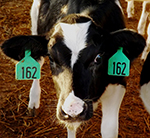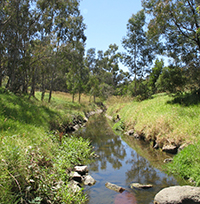NMPF Seeking Applicants for 2015 Dairy Scholarship Program
December 04, 2014 NMPF is accepting applications for its National Dairy Leadership Scholarship Program for academic year 2015-2016. Qualified students must be enrolled in a Master’s or Ph.D. program and conducting research of interest to NMPF-member cooperatives and the dairy industry in general.
NMPF is accepting applications for its National Dairy Leadership Scholarship Program for academic year 2015-2016. Qualified students must be enrolled in a Master’s or Ph.D. program and conducting research of interest to NMPF-member cooperatives and the dairy industry in general.
Applicants do not need to be affiliated with NMPF members. Recommended fields of study include agricultural communications, dairy science, animal health, animal or human nutrition, bovine genetics and herd management.
The top applicant each year receives the Murray Hintz Memorial Scholarship, named in honor of the late board chairman for Cass-Clay Creamery, Inc., in Fargo, ND. The cooperative played a key role in establishing the scholarship program.
The deadline for applying for scholarships is March 27, 2015. For an application or for additional information, visit the NMPF website or call NMPF at 703-243-6111.
NMPF CEO Joins Humane Treatment Group in Discussing Proper Animal Care
December 04, 2014 NMPF President and CEO Jim Mulhern joined the country’s oldest humane animal treatment organization, a top chef and others in a mid-November panel discussion about commitment to proper farm animal care.
NMPF President and CEO Jim Mulhern joined the country’s oldest humane animal treatment organization, a top chef and others in a mid-November panel discussion about commitment to proper farm animal care.
Organized by the American Humane Association, the briefing was meant to thank those working for better animal treatment and to encourage support for humane farming practices, especially during the holiday season.
Mulhern, representing the dairy industry, told the group a commitment to humane care is not only good for dairy cows but for consumers and dairy farmers as well. “In addition to the moral imperative of quality animal care, well-treated cows are the key factor in the production of high quality milk upon which dairy farmers’ livelihoods depend,” he said. “Simply put, what’s good for cows is good for the farmers who milk those cows.”
Also participating in the briefing were prominent chef Douglas Keane from Sonoma County, California; Animal Agriculture Alliance President Kay Johnson Smith, and Eggland’s Best CEO Charles Lanktree.
In recent years, NMPF has developed an animal care program that combines a comprehensive set of best practices with education, evaluation and third-party verification to assure adherence on farms. Today, nearly 80 percent of the milk produced in the country comes from farmers meeting the program’s standards.
NMPF recently improved the reach of the program, called Farmers Assuring Responsible Management, by requiring all farms that supply participating companies to be enrolled and evaluated for their animal care practices.
2014 Edition of Dairy Data Highlights Now Available
December 04, 2014The 2014 edition of Dairy Data Highlights, NMPF’s guidebook of national and state milk and dairy production statistics from the 1970s through recent years, is now available.
The pocket-sized booklet is available to NMPF members and associate members for $7.50 each, or $5 for orders of more than 10. For nonmembers, the cost is $10 for single copies or $7.50 for bulk orders. Use the order form on the NMPF website.
All aspects of milk and dairy products production are covered, as well as producer, wholesale and retail milk and dairy product prices; federal milk marketing orders; sales and consumption data for milk and dairy products, and comparative information for U.S. dairy imports and exports.
New this year is a table showing historical monthly income-over-feed cost margins, as defined by the 2014 farm bill for the new Margin Protection Program. The table goes back to January 2000.
Clarify or Withdraw WOTUS Regulation, NMPF Tells EPA
December 04, 2014 NMPF has proposed a series of changes to the Environmental Protection Agency’s controversial Waters of the U.S. regulation, asking either that its recommendations be included in the current draft, or that EPA withdraw and rewrite the rule.
NMPF has proposed a series of changes to the Environmental Protection Agency’s controversial Waters of the U.S. regulation, asking either that its recommendations be included in the current draft, or that EPA withdraw and rewrite the rule.
In lengthy comments, NMPF stressed that, above all, agriculture needs certainty on which waterways fall under the jurisdiction of the Clean Water Act, and which do not. It asked EPA to clarify numerous terms in the regulation, including “other waters,” “upland ditches,” ‘‘floodplain,’’ ‘‘tributary,’’ and ‘‘significant nexus.”
In addition, NMPF urged that any final regulation exclude from federal jurisdiction intermittent streams and wetlands adjacent to excluded streams. NMPF also asked EPA to publish maps clearly indicating the features that make a waterway covered under the CWA.
“Clean water is essential to milk production and the dairy industry is very willing to work with EPA to protect U.S. waters,” said NMPF President and CEO Jim Mulhern. “But EPA’s draft would only lead to more confusion and uncertainty around which waterways fall under the jurisdiction of the Clean Water Act.”
NMPF submitted 23 pages of comments on the regulation, along with additional comments on EPA guidance for when farmers must seek CWA permits for a long list of normal farming activities near wetlands.
Issued in March, the draft WOTUS regulation expanded the waterways covered under the Clean Water Act to nearly all those connected to U.S. navigable waters. EPA received more than half a million comments on the rule.
CWT Export Assistance in November Continues to Support U.S. Dairy Product Prices
December 04, 2014 During the month of November, Cooperatives Working Together helped members export 7 million pound of cheese, 3 million pounds of butter and 18 million pounds of whole milk powder. That brought year-to-date totals for CWT-assisted sales to more than 99 million pounds of cheese, 54 million pounds of butter and 57 million pounds of whole milk powder. The sales to customers in 45 countries on six continents are the equivalent of 2.5 billion pounds of milk on a milkfat basis.
During the month of November, Cooperatives Working Together helped members export 7 million pound of cheese, 3 million pounds of butter and 18 million pounds of whole milk powder. That brought year-to-date totals for CWT-assisted sales to more than 99 million pounds of cheese, 54 million pounds of butter and 57 million pounds of whole milk powder. The sales to customers in 45 countries on six continents are the equivalent of 2.5 billion pounds of milk on a milkfat basis.
CWT is a voluntary, farmer-funded program that helps member cooperatives maintain and expand world markets for U.S. dairy products. At the NMPF annual meeting in October, President and CEO Jim Mulhern credited CWT with helping to keep U.S. dairy product prices high amid a steep decline in dairy prices worldwide. By moving U.S. dairy products into world markets, Mulhern said, the NMPF-developed program has helped keep domestic inventories low and strengthened milk prices across the board.
NMPF Talks with Pacific, European Negotiators on Free Trade Agreements
December 04, 2014 NMPF has held extensive consultations with key negotiators on the Trans-Pacific Partnership trade pact in advance of a meeting set for Washington during the second week in December. NMPF staff has been in constant communications with U.S. TPP negotiators, and traveled to China in November for discussions with U.S. negotiators and others involved in the Asia-Pacific Economic Cooperation forum.
NMPF has held extensive consultations with key negotiators on the Trans-Pacific Partnership trade pact in advance of a meeting set for Washington during the second week in December. NMPF staff has been in constant communications with U.S. TPP negotiators, and traveled to China in November for discussions with U.S. negotiators and others involved in the Asia-Pacific Economic Cooperation forum.
The Washington meeting next week is aimed at helping drive the TPP trade talks to a close. The dairy industry is seeking increased access for U.S. dairy products in Japan and Canada as a key outcome of the talks involving 12 Asian and Pacific countries.
In early December, NMPF staff also traveled to Brussels for meetings with European Union officials on the planned U.S.-EU trade agreement, and for talks with the Danish government about its plan to ban use of the term “Havarti” by non-Danish companies. Denmark is seeking a Geographical Indication that would limit Havarti to only cheese produced within its borders.
Havarti is widely produced in the United States and is also the subject of an international standard. NMPF says a GI for Havarti would create a troubling precedent that could affect use of other cheese names, including mozzarella and provolone.
NMPF has strongly opposed efforts to erode international cheese standards through its leadership in the Consortium for Common Food Names, an alliance of organizations seeking model worldwide geographical indication guidelines.
NMPF’s Mulhern Reiterates Need for Real Reform in Wake of Executive Order on Immigration
December 04, 2014 In the wake of the Obama administration’s action last month to delay deportation for up to five million undocumented immigrants, NMPF joined other agriculture groups in re-emphasizing the need for comprehensive reform of the broken immigration system.
In the wake of the Obama administration’s action last month to delay deportation for up to five million undocumented immigrants, NMPF joined other agriculture groups in re-emphasizing the need for comprehensive reform of the broken immigration system.
“The executive action announced by the White House will not solve the current or future needs of dairy farmers,” said NMPF President and CEO Jim Mulhern in a statement. “We still need congressional action in 2105.”
Mulhern said NMPF’s focus going forward will remain on securing a permanent fix for the nation’s immigration laws. “Regardless of the executive order, we must continue pressing for a long-term, meaningful solution that provides permanent relief for current workers and future labor needs,” he said. “It is imperative that Congress address this issue in 2015 and resolve it, once and for all.”
President Obama’s mid-November order didn’t specifically address agriculture, but a small fraction of undocumented U.S. farm workers – estimates range from 250,000 to 450,000 – will still be eligible for work permits and deportation relief under the plan. Republicans in Congress are expected to counteract the White House action, although the precise mean to challenge the immigration action remains to be seen.
House Passes One-Year Extension of Section 179 Tax Provision
December 04, 2014 In early December, the House passed and sent to the Senate a one-year extension of more than 50 expired tax breaks, including an important one for farmers that NMPF strongly supported. The Senate is expected to pass the so-called “tax extenders” bill before adjourning for the holidays, but it is uncertain whether it will be identical to the House bill.
In early December, the House passed and sent to the Senate a one-year extension of more than 50 expired tax breaks, including an important one for farmers that NMPF strongly supported. The Senate is expected to pass the so-called “tax extenders” bill before adjourning for the holidays, but it is uncertain whether it will be identical to the House bill.
The House bill, which passed 378 to 46, allows small businesses, including farms, to write off capital purchases such as equipment immediately, instead of over time.
In November, NMPF joined 41 other agricultural organizations in urging Congress to include this provision, known as Section 179, in any tax bill considered in its post-election session. The farm groups asked that the maximum amount of annual expensing be restored to $500,000, as it was in 2013. In addition, they asked Congress to reinstate the 50 percent bonus depreciation for the purchase of new capital assets, including farm equipment.
“Farming requires significant investments in machinery and equipment,” said NMPF President and CEO Jim Mulhern. “By allowing farmers to immediately write off these purchases, Section 179 gives producers an incentive to invest in their businesses while it reduced their record-keeping burden.”
A one-year restoration of Section 179 would reinstate the provision for 2014 only. If final tax legislation does not clear the Congress this month, the issue is likely to return in January.
Sign-Up Deadline for New Dairy Safety Net Pushed Back to December 19
December 04, 2014 Farmers have two more weeks to sign up for the revamped dairy safety net included in the 2014 farm bill. The Agriculture Department extended the enrollment deadline for the Margin Protection Program a second time on December 4. The new deadline is Friday, December 19.
Farmers have two more weeks to sign up for the revamped dairy safety net included in the 2014 farm bill. The Agriculture Department extended the enrollment deadline for the Margin Protection Program a second time on December 4. The new deadline is Friday, December 19.
NMPF, which had pushed for the extension, thanked the Agriculture Department for giving farmers more time. “With a busy harvest season and the favorable milk prices of recent months, many dairy farmers are just now taking the time to review their options and explore the need for the new program,” President and CEO Jim Mulhern said.
Mulhern said there are several good reasons for farmers to sign up for MPP now. “First,” he said, “the strong milk prices of 2014 are giving way to lower prices, which should prompt many to consider what type of risk management they need if prices drop further, or if feed costs soar.”
Mulhern cited the recent oil price crash as an example of how sudden changes can catch many by surprise. “No one expected oil prices would drop by 40 percent in just a few months,” he said, “but sudden movements up or down are frequent in commodity markets.”
In addition, Mulhern said, with U.S. milk production expected to increase by more than one percent this year, signing up for MPP boosts an individual farm’s production history going forward by the same amount as the national increase.
“MPP payments are based on past production, and that production history increases only with the rise in national milk production,” Mulhern said. “As a result, those who sign up now for 2015 coverage will benefit from this year’s increase in milk production, thus allowing them to insure a larger base in the future.”
NMPF has a variety of tools on its website and on a separate website devoted exclusively to the new program to help producers make their decisions. Included is a downloadable calculator on which producers can plug in their own numbers and get a sense of the program’s impact on their farm. Farmers who have already enrolled have the opportunity to change their coverage levels until December 19th.
“The most important New Year’s resolution a dairy farmer can make for 2015 is using the new Margin Protection Program to guard against low margin conditions at some point in the next year,” Mulhern said.





